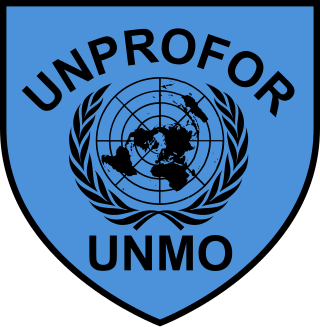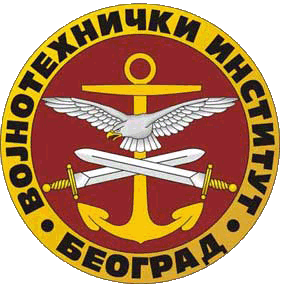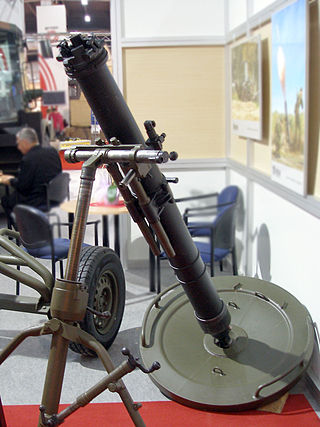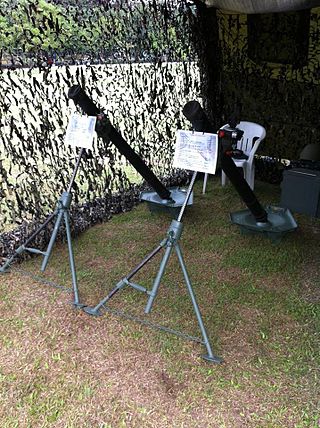
The Siege of Sarajevo was a prolonged blockade of Sarajevo, the capital of Bosnia and Herzegovina, during the Bosnian War. After it was initially besieged by the forces of the Yugoslav People's Army, the city was then besieged by the Army of Republika Srpska. Lasting from 5 April 1992 to 29 February 1996, it was three times longer than the Battle of Stalingrad, more than a year longer than the siege of Leningrad, and was the longest siege of a capital city in the history of modern warfare.

The United Nations Protection Force was the first United Nations peacekeeping force in Croatia and in Bosnia and Herzegovina during the Yugoslav Wars. The force was formed in February 1992 and its mandate ended in March 1995, with the peacekeeping mission restructuring into three other forces.

Operation Deliberate Force was a sustained air campaign conducted by NATO, in concert with the UNPROFOR ground operations, to undermine the military capability of the Army of Republika Srpska, which had threatened and attacked UN-designated "safe areas" in Bosnia and Herzegovina during the Bosnian War with the Srebrenica genocide and Markale massacres, precipitating the intervention. The shelling of the Sarajevo marketplace on 28 August 1995 by the VRS is considered to be the immediate instigating factor behind NATO's decision to launch the operation.

The M-84 is a Yugoslav main battle tank, a variant of the Soviet T-72 tank. The M-84 is still in service in Croatia, Serbia, Bosnia and Herzegovina, Slovenia and Kuwait.

The Markale market shelling or Markale massacres were two separate bombardments, with at least one of them confirmed to have been carried out by the Army of Republika Srpska, targeting civilians during the siege of Sarajevo in the Bosnian War. They occurred at the Markale (marketplace) located in the historic core of Sarajevo, the capital of Bosnia and Herzegovina.

The 122-mm howitzer D-30 is a Soviet howitzer that first entered service in 1960. It is a robust piece that focuses on the essential features of a towed field gun suitable for all conditions. The D-30 has a maximum range of 15.4 km (9.6 mi) or 21.9 km (13.6 mi) using rocket-assisted projectile ammunition.

M-63 Plamen is a 128mm multiple rocket launcher developed in 1963 in Yugoslavia for use in the Yugoslav People's Army.
The 1992 Yugoslav People's Army column incident in Tuzla, also known as Tuzla column was an attack on the 92nd Motorized Brigade of the Yugoslav People's Army (JNA) in the Bosnian city of Tuzla on 15 May 1992. The incident occurred at the road junction of Brčanska Malta. At least 54 soldiers of the JNA were killed and 44 wounded during the attacks. What started off as a peaceful retreat by agreement with local authorities ended in an ambush, when Patriotic League, Green Berets and Bosniaks from local police attacked the column. It was a repeat of a similar incident that occurred in Sarajevo a week prior.

The NATO intervention in Bosnia and Herzegovina was a series of actions undertaken by NATO whose stated aim was to establish long-term peace during and after the Bosnian War. NATO's intervention began as largely political and symbolic, but gradually expanded to include large-scale air operations and the deployment of approximately 60,000 soldiers of the Implementation Force.

The M-56 Howitzer is a 105 mm artillery gun from Serbia and Bosnia and Herzegovina. Early towed version is comparable to the German 10.5 cm leFH 18 and the American M101 howitzer while newer M-56A1 and self propelled M-09 Soko has more improvements and greater range.

Military Technical Institute is a Serbian weapons and aircraft design institute, headquartered in Belgrade, and governed by the Serbian Ministry of Defence. It is a top-level military scientific research institution in Serbia, dealing with research and development (R&D) of new weaponry and military equipment as well as with upgrade of the inventory for both branches of the Serbian Armed Forces: Army and Air Force and Defence.
Operation Una was a military offensive conducted by the Croatian Army against the Army of Republika Srpska in western Bosnia and Herzegovina on 18–19 September 1995, during the Bosnian War. The operation entailed a crossing of the Una and Sava rivers to establish bridgeheads at Novi Grad, Bosanska Dubica, Bosanska Kostajnica and opposite Jasenovac to allow for a subsequent advance towards Prijedor and Banja Luka.
The M74 mortar is designed by Military Technical Institute in Yugoslavia. It is smooth bore, muzzle-loading, high-angle-of-fire weapon used for long-range indirect fire support. Today they are produced by Serbian company PPT Namenska and BNT from Bosnia and Herzegovina.

The Yugoslavian 60mm M57 Mortar was generally based on the design of the US 60mm M2 Mortar. Currently, the M57 Mortar is produced by the Serbian company PPT Namenska, and is still used by the 72nd Brigade for Special Operations of the Serbian Armed Forces.
The Battle of Orašje was fought during the Bosnian War, from 5 May to 10 June 1995, between the Bosnian Serb Army of Republika Srpska and the Bosnian Croat Croatian Defence Council for control of the town of Orašje and its surrounding area on the south bank of the Sava River. The offensive codenamed Operation Flame-95 and referred to by Croatian sources as Operation Revenge was actually fought with varying intensity, with periods of combat interspersed by lulls lasting two to seven days. The heaviest fighting was reported on 15 May, when the VRS managed to break through a portion of the HVO defences near the village of Vidovice, but the breach was successfully contained and the lost ground was recovered by the HVO.

Krušik Holding Corporation is a Serbian state-owned company for the production of defense and civil related equipment, with the headquarters in Valjevo, Serbia.

The 120mm М95 Long Range Mortar is a 120 mm (4.7 in) mortar that was developed by Serbian Military Technical Institute. It is long-range and heavier mortar compared to the light mortar 120mm M75 and represents further development of Universal Mortar UB M52.

The Universal Mortar UB M52 is a 120 mm mortar that was developed by Military Technical Institute, in former Yugoslavia. It is long-range heavy mortar developed from the Soviet M1938 mortar but with integral wheels carriage.

The M69 81 mm/82 mm medium weight mortar is a Yugoslavian-designed smooth bore, muzzle-loading, high-angle-of-fire weapon used for long-range indirect fire support to light infantry.

Saudi–Serbian relations refers to bilateral relations between Saudi Arabia and Serbia.
















